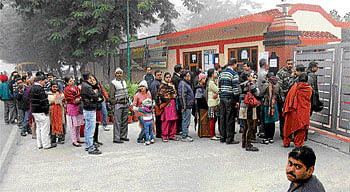Nursery admissions are now associated with criticism, confusion and chaos

Long queues of anxious parents waiting outside schools, while braving the severe winter chill to buy nursery admission forms, have become a common sight every year.
The sale of forms for the academic year 2012-2013, which started on January 2, was no different. Nursery admissions have been associated with criticism and confusion for the last few years. Before the introduction of the point system, schools used to take tests and interview children as well as their parents, which were termed discriminatory and unfair.
“Every school was coming up with their own rules regarding nursery admissions, leaving parents helpless. Then the Delhi High Court accepted the Ganguly Committee report to start a uniform admission process,” said advocate Khagesh Jha of Social Jurist.
“The report recommended that schools should have a point system, divided into categories like neighbourhood, siblings of students already enrolled, children of alumni, management and staff, among others. It also mentioned that the minimum age for nursery admission should be four years.”
The 100-point system was introduced in all schools in the city in January 2008. This had been followed for three years. The Delhi government then started a new point system for nursery admissions in 2011, which allowed schools to give points to applicants based on factors they deemed reasonable, except for a few categories that were not allowed by the government.
While the point system did away with tests and interviews and gave some relief to parents, the division of categories as per the schools’ wish created more confusion.
“Several schools gave maximum points to the siblings and alumni categories. Then the division of points in other categories gave no chance to students who don’t come under any category,” said Sumit Vohra, founder of admissionsnursery.com, a forum to help parents during admissions.
Twenty-five per cent seats were also reserved in all schools for students coming under the Economically Weaker Section (EWS) category. Despite these steps taken by the government to streamline the admission process, chaos and confusion persist.
“Parents are anxious; they are trying to get their children admitted in a few well-known schools. But parents must know that schools have only created the brands themselves,” said Ameeta Mulla Wattal, principal of Springdales School, Pusa Road. Springdales School got over 5,000 forms for its 300 nursery seats.
“With all the categories, 20 per cent management quota and another 25 per cent for EWS, schools are hardly left with any seats. In my school, only 45 seats are left after excluding other quotas. We sold over 4,500 forms in general category and 650 forms in EWS in the first week,” Wattal said.
According to the Directorate of Education (DoE), there are 950 schools functioning under the DoE, 1,750 under the MCD, 82 under NDMC and there are 1,187 public unaided schools recognised by the DoE.
According to Jha, there are at least 1,200 public unaided unrecognised schools in the city. Education experts feel limited number of seats, despite the presence of many schools, is the major reason for the chaos during admission season. The number of schools having nursery sections are also limited with more and more children being admitted to kindergarten.
“The Delhi government gave land to the DDA to set up 392 private unaided schools, of which 150 are for nursery classes. At least two lakh students apply every year for admissions,” said RC Jain, president of Delhi State Public Schools Management Association.
“But parents try to admit their kids in only 100 reputed schools. These 100 schools don’t have more than 20,000 seats. If there is 20 per cent management quota and 25 per cent EWS quota, the rest 55 per cent is not enough for the general category. For 11,000 seats in the general category in these 100 schools, lakhs of students apply,” said Jain.
According to Jain, some of the most sought-after schools are Delhi Public School, K R Mangalam School, Apeejay School, Amity School, Bal Bharati, Springdales, DAV Schools, Alchon Public School and Blue Bells School, among others.
He said problems in nursery admissions also rose when the government stopped giving DDA land to schools in 2002.
“Schools that are not built on government land need permission from the MCD just to build a new floor. Though it can accommodate more students, schools have to pay Rs 29,050 per sq ft,” added Jain.
Many schools in South Delhi, East Delhi and Narela are built on non-government land. “Many schools feel helpless because they have to pay a lot of money to add an extra floor, while schools that are on DDA land, such as Delhi Public School and Modern School, can build new floors free of cost,” said Jain.
Of 950 government-run schools, 53 have stopped holding evening classes, and only 300 manage to run evening classes as of now,” Jain said.
“In over 1,700 MCD schools, the government halted 217 evening shift schools. Evening shift should be made available if there is infrastructure. Schools that have primary classes can hold evening sessions for 6th, 7th and 8th standards. Schools that have classes till 8th standard can have evening classes for 9th, 10th, 11th and 12th standards,” said Jain.